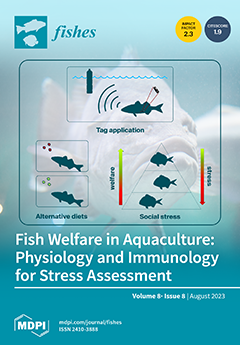Suppressor of cytokine signaling (SOCS) genes are essential negative regulators that modulate cytokine signaling and play key roles in numerous biological processes, including immune responses. In this study, we cloned the complementary DNA (cDNA) sequences of two SOCS genes, designated as
LvSOCS6
[...] Read more.
Suppressor of cytokine signaling (SOCS) genes are essential negative regulators that modulate cytokine signaling and play key roles in numerous biological processes, including immune responses. In this study, we cloned the complementary DNA (cDNA) sequences of two SOCS genes, designated as
LvSOCS6 and
LvSOCS7, from the whiteleg shrimp,
Litopenaeus vannamei.
LvSOCS6 encoded a polypeptide of 463 amino acids (aas), spanning 1392 base pairs (bps), while
LvSOCS7 encoded a significantly larger polypeptide of 955 aas, encompassing 2868 bps. Both
LvSOCS proteins exhibited conserved domains associated with SOCS, including a centralized Src homology 2 (SH2) domain and a C-terminal SOCS box. Phylogenetic analysis revealed that the deduced aa sequences of
LvSOCS6 and
LvSOCS7 clustered within the invertebrate type I SOCS family, indicating their evolutionary relatedness. Tissue distribution analysis demonstrated ubiquitous expression of both
LvSOCS genes across all examined tissues, with
LvSOCS6 showing heightened expression in the gills and
LvSOCS7 in the gills and stomach. Notably, mRNA expression patterns of
LvSOCS genes following LPS and poly (I:C) stimulations exhibited significant upregulations, while PGN stimulation yielded incongruous results across the examined tissues. Interestingly, concurrent with the diminished expression of
LvSOCS6 and
LvSOCS7, there was significant elevation in mRNA expression levels of
LvSTAT, a vital component of the Janus kinase (JAK)/signal transducer and activator of transcription (STAT) pathway. These findings shed light on the potential involvement of the newly discovered type I SOCS genes in regulating the JAK/STAT pathways and playing pivotal roles in orchestrating the innate immune responses in
L. vannamei defense mechanisms.
Full article





